|
Vintage Motorcycle Days 2015 |
Background - 2009-2015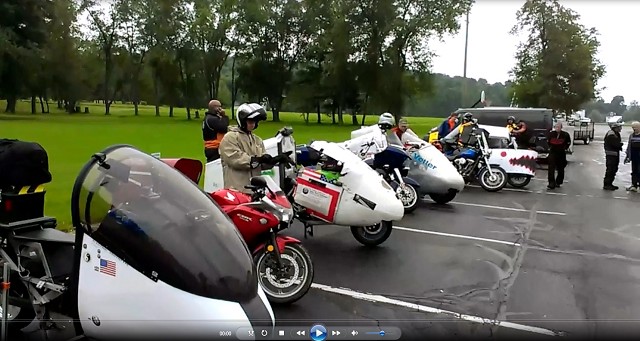 Each year, since 2009, Schultz Engineering has attended Vintage Motorcycle Days to spend time with Craig Vetter and his friends who are working on improving motorcycle performance through streamlining. The Delta-11 prototype was designed and built in 2011 to specifically compete and win a 2011 Craig Vetter Fuel Economy challenge. However, due to timing and lack of funding, the bike was never fully completed (the streamlining for the tail is still not complete). In the years 2011, 2012, 2013, 2014 all that would be required to win the challenge would be to have enough batteries on board to finish the Challenge distance. Alas, much to my (Kraig Schultz's) chagrin, we always fell short due to lack of funding. EVERY year since 2011, the Electric bikes outperformed the fossil fueled bikes in efficiency, but lacking range could not complete the entire course and in not completing, be disqualified from winning. Definintion of Chagrin: "distress or embarrassment at having failed or been humiliated". So, it became an Ego challenge. Would we compete and fail to complete the course yet another year?! The stupid thing is, there is no prize money and little public recognition for the winners of the event. It's just about personal bragging rights. In addition, the best thing about the event is what you learn from your fellow competitors and developing personal relationships. But, still, dang it, I want to WIN! With the purchase of Chevy Volt batteries in 2015, it became technically possible to complete the Vetter Challenge. All that was required was to fit all those batteries on the bike in time for the event. The "challenges" of the project included: With investment in bike upgrades, travel time, travel expense it is relatively expensive to compete in the Vetter challenge ($5,000 + this year) Electric bikes would need to complete the route of up to 160 miles round trip with just one hour recharge at the mid-point. Gas prices were the lowest they had been in 5 years, and if Gasoline tax was added on to the electric bikes they would need to be VERY aerodynamic. The bike and charging equipment would need to be waterproof so they could ride in the rain The mid-point was known to lack electrical infrastructure to recharge multiple bikes The exact route and speed were unknown, but it was known that the route would be tailored to ride "the way Gasoline bikes ride" - i.e. fast top speeds, quick take-offs, and without taking breaks Electric competitors Terry Hershner and Richard Goff both had competed with more fully streamlined electric Zero Motorcycles in 2014 demonstrating better efficiency than the Delta-11 partially streamlined. Schultz Engineerings, 2015 project goal was to not only compete in the Vetter Challenge, but also, ride the bike to the event and back (700 mile round trip). Kraig was asked to prepare a talk for Vintage Motorcycle Days on the State of Electric motorcycles. |
|
Hectic Preparation 2015 Vetter Challenge Between April 30 and July 9th, the following preparations were completed: Find courage, money and time to do this project while working a full time job outside of Schultz Engineering Purchase supplies required to compete without endangering Kraig's 24 year marriage Install and test Chevy Volt Batteries Build and test trailer Purchase and Install new controller Waterproof Bike Find charging near musuem for multiple bikes Prepare talk on future of electric motorcycle Make bike able to tour without support vehicles Prepare support vehicle/driver in case it would be required |
|
The Trip to the 2015 Vetter Challenge - Attempt #1 The work was complete, I was physically exhausted, but at 7:30pm on July 9th I was ready to head out for Ohio on the Delta-11 proto-type! 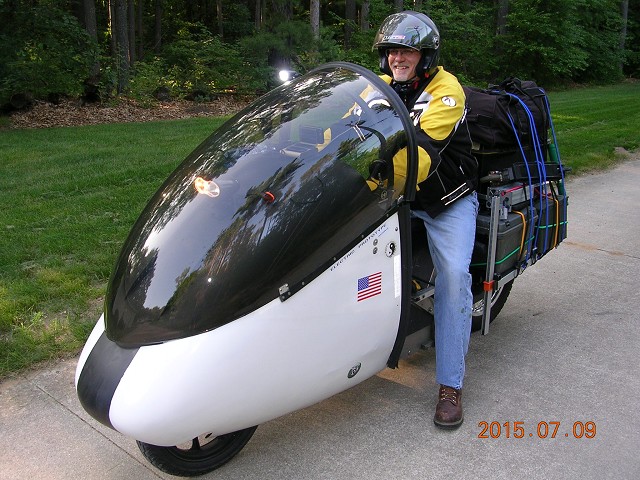 The plan was to ride to VMD in Ohio, participate and then ride on to Cinncinati, Ohio where I'd meet my support vehicle for a ride home. I was worn out, but I figured, I'll ride the first leg tonight, get the bike on charge at the hotel 150 miles into the ride while I get some sleep, in the morning I'll ride again early. With luck I could get to Ohio by Saturday morning where I would give my talk on the state of electric motorcycles. 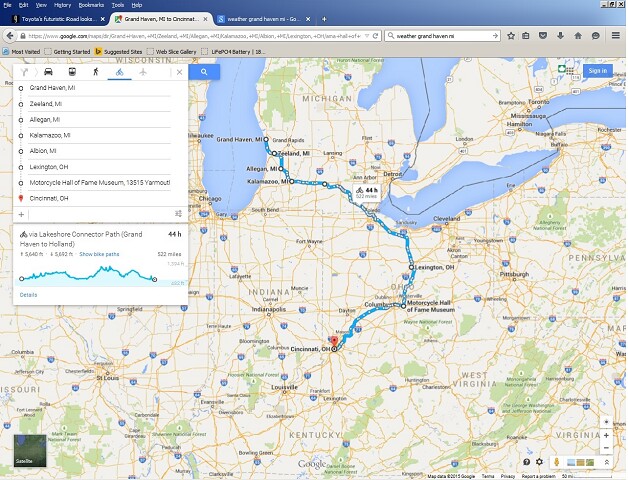 At the first recharge point I realized I had a huge problem. It was taking over 1/2 hour to unpack/repack the charging equipment from the waterproof containers. Also, people were gathering around during the process and if I made a mistake, I could burn up un-replaceable equipment. And the set-up looked like a science project gone wrong. The bike was very top heavy loaded with all this gear - it was not a joy to ride as it needed constant course correction to keep it from wandering on the road. I discovered that by running one battery out and leaving the other full, I'd need to fast charge the drained battery (2 chargers per battery) to have fast recharge times - this is hard on the batteries, it would be better to have both battery packs discharged to the same level when stopping, that way each battery can have one charger attached for "slow charging". Here is a picture of the bike after repacking it in Allegan after the first recharge. Go on, or abort? 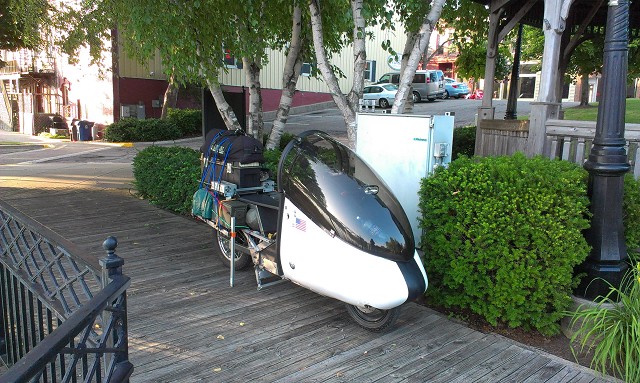 With reluctance I returned to home base. Here is the bike in the Science Project recharge mode. This is not a good public image! OK for behind closed doors, but not a good way to market the toruing capability's of electric motorcycles. The lesson is this: charging must be simple to plug in. Just take the plug, plug it into the wall and walk away. There must be no thinking involved and less than 30 seconds plug in. 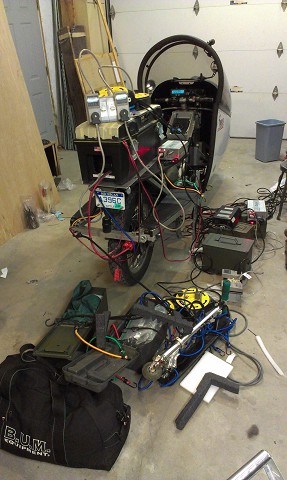 |
|
The Trip to the 2015 Vetter Challenge - Attempt #2 With a night of sleep and fresh perspective. I decided to have one last try at making the trailer work. I would reconfigure the bike to put a single battery on the trailer, along with keeping some chargers out and ready to go the instant I stopped. The support vehicle would trailer the bike/trailer to a convienient location where the support vehicle would go to Cinncinati and the bike would ride to Lexington. The bike was test ridden in the new configuration. 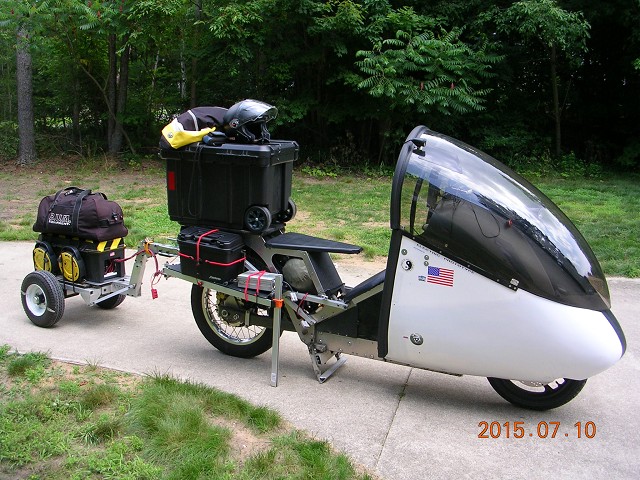 Then we packed the bike and family into the van for the trip to Ohio. Here we are at the first pit stop. 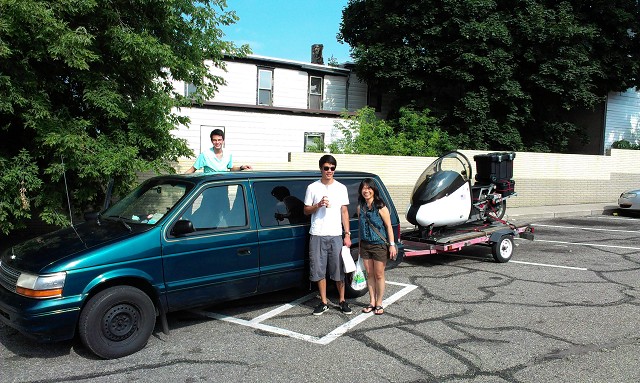 Here is packing up things on the bike the next morning. Note, all but one bag is charging equipment required to fast charge! 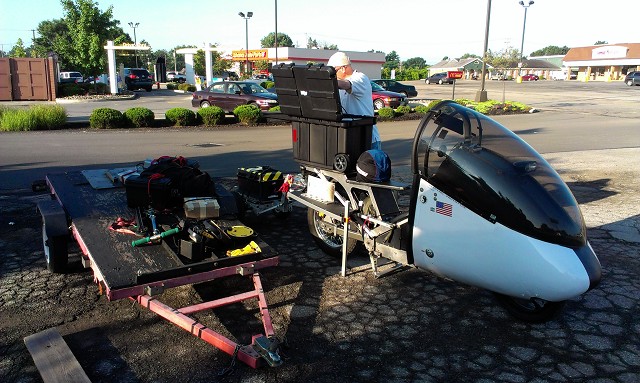 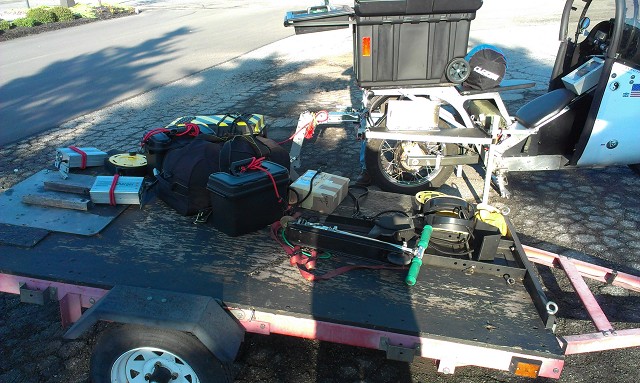 Here is how it arrived at the Goodyear tower at Mid-Ohio Raceway on Saturday morning.  Guest speakers to support the State of Electric Motorcycle Talk (Left to Right, Kraig Schultz, Scot Harden, Richard Goff, Craig Vetter). The talk went very well and was recorded by Burton Rosenburger. I will definately do talks like this in the future. Invite experts, ask questions and sit back and enjoy hearing expert commentary on a subject! Download the presentation slides at http://www.schultzengineering.us/state-2015.pdf Watch a video of the presentation at https://www.youtube.com/watch?v=lkLlrFDHXSQ Key take aways from the speakers: Craig Vetter: "Itís the only energy you can produce at home!" Richard Goff: "Take a test ride." Scot Harden: "Itís about the experience...Thrill, Adventure, Control... Itís the closest thing you can find to a magic carpet ride in this day and age. Every time I ride, itís like the first time I rode a motorcycle. That childlike pure joy of doing something thatís really cool...and thatís what I get when I ride an electric motorcycle." Kraig Schultz: "Never buy gas again!" 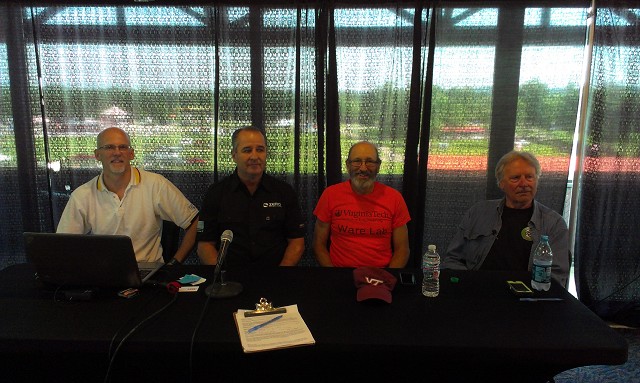 After the talk we had fun talking with the public while Craig Vetter's dog (named Riley) enjoyed hanging out in the back of his streamliner. 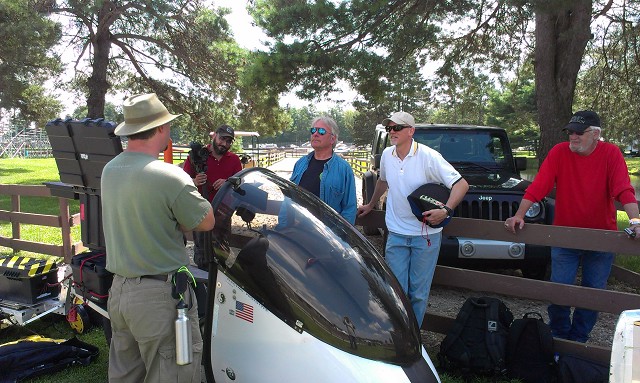 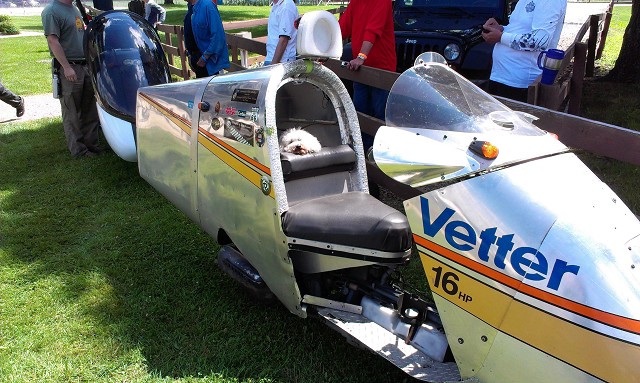 Cleanest streamliner conversion at the event. This is one very nicely done project by Finney Wagaman of York, PA. 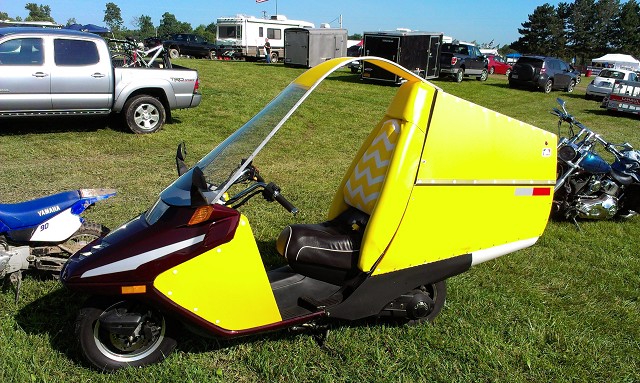 Saturday evening we had the riders meeting. 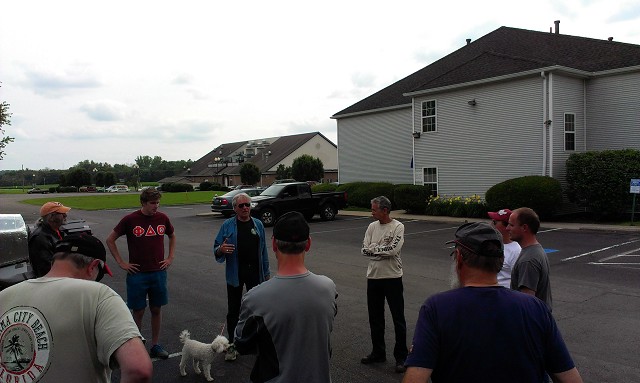 After that I let Vic Valdes and Alan Smith test ride the Delta-11 proto-type (the first time anyone other than Kraig has ridden the bike). Here is Vic all suited up ready to ride the "spaceship". 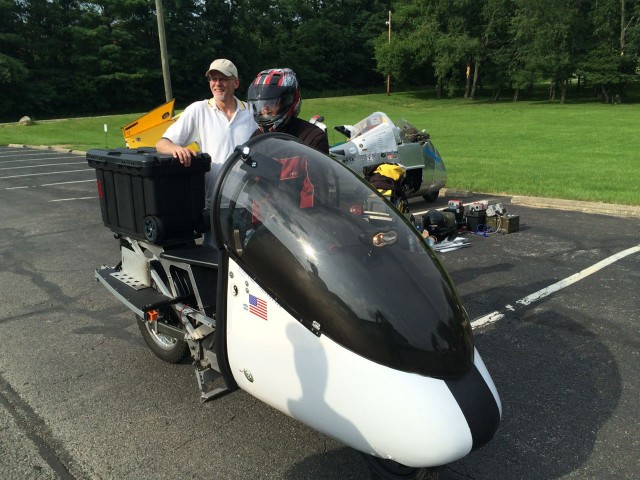 Many of us went to Burger King to talk while eating dinner. 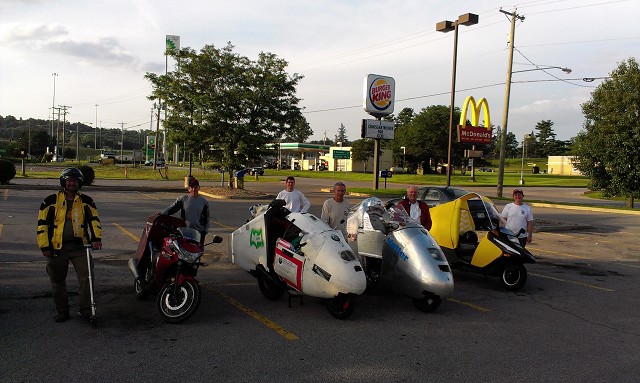 |
|
Vetter Challenge 2015 Report - July 12, 2015 Report from Kraig Schultz. SUNDAY MORNING, JULY 12, 2015: Fully fueled, the Vetter Challengers gathered to depart for the AMA Musuem.  ELECTRIC RIDER SUMMARY: (figures below assume $.12/kWh, however, electric riders actually recharged for free at all charging locations) Benjamin Nelson, Vectrix with Nissan Leaf Batteries 55.8 miles. 6,130 Watt-hours, 109.86 Watt-hrs/mile, $.0132 / mile + Vetter road tax. Richard Goff, 2013 Zero DS with Corroplast Streamlining 135.4 miles, 13.140 kilo-Watts from the wall, 97.05 watts-hr per mile, $0.0116 / mile + Vetter road tax. Kraig Schultz, Delta-11 Prototype with Chevy Volt Batteries 64.14 miles, 5.920 kilo-Watt-Hours from the wall to recharge, 92.3 Wh/Mile (from the wall), $.0111/Mile + Vetter road tax. The Vetter challenge ride at vintage motorcycle days is always hard because of the combination of long distance, fast speeds and limited charging. 2015 was no exception. The ride was advertised to be from Splash Harbor, to the Mid-Ohio track for a lap of the track and then down to the AMA Museum and back. The exact route was not announced until the morning of the ride. A route of 87.5 miles each way (including highway). This distance was more than any of the electric bikes could complete without several hours of charging at the museum. So, the electric riders selected a different route with the same starting point and ending point. Two of the three electric's completed their planned ride without trailoring. All enjoyed the ride and fellowship. Ben Nelson published a great trip report at: http://300mpg.org/2015/07/13/300mpg-orgs-electric-vectrix-wins-craig-vetter-fuel-economy-competition/ GROUP RIDE PLANNING: There were three battery powered motorcycles at VMD this year. Left to Right: Richard Goff's 2012 Zero DS, Schultz Engineering's Delta-11 prototype and Ben Nelsons Vectrix. 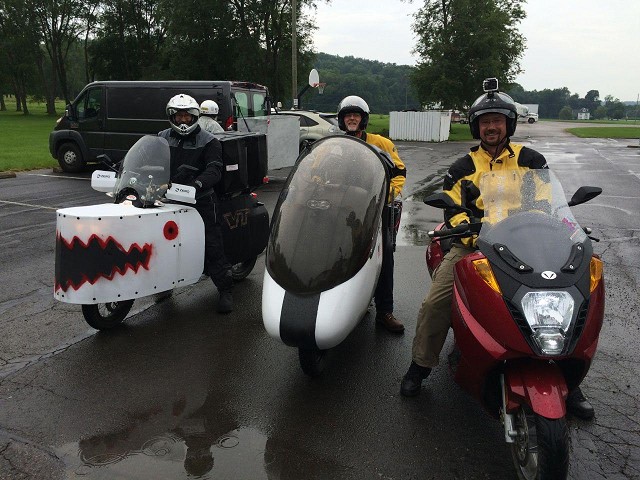 Each rider had special challenges and different goals for competing in the Vetter Challenge. There was much discussion between the electric riders about how to complete the challenge successfully. The advertised ride distance of 150 miles at 50-70 mph is a challenge for even the best electric motorcycles. We considered leaving early and riding a bit slower to conserve energy. We discussed various strategies to overcome the limited charging resources available at the official half way-point. We discussed our limitations and what we thought was the best we could expect to achieve during the ride. LIMITED CHARGING RESOURCES: The electric riders recognized that there would not be enough time or charging outlets at the museum for three bikes to recharge at once. Richard planned to recharge at the museum and attempt to ride both ways with the Fossil Fuel bikes. Kraig planned to recharge near the museum at a residential Plug Share RV50 plug-in before riding on to Cincinnati alone. Ben hoped to ride to the museum and trailer his bike back to Mid-Ohio and recharge there. Both Kraig and Ben were considering leaving early and not riding with the Fossil Fuel bikes so they could ride at reduced speeds to save fuel and extend their range. BENS BIKE: Ben Nelson was running an untested pack made from Nissan Leaf Batteries and carrying only one stock Vectrix charger that would take 4.5 hours to fully recharge his pack. Ben was confident he could NOT make it 75 miles at the normal Vetter challenge speeds. He felt his best bet was to leave a little early and ride at a slower pace so that he could at least be at the museum at the same time as the fossil fueled bikes. Unfortunately, due to rain and having to recharge the bikes after riding them from Mid-Ohio at the official starting point, the electric bikes did not leave early. We were also delayed waiting to find out if the ride would be cancelled due to severe weather and waiting to find out what the official route would be. Then, just minutes before the ride was scheduled to begin, ride maps were circulated showing the course would be 87.5 miles each way (175 miles total)! All the electric riders agreed that the proposed 87.5 mile route was outside their range. So, they proposed an untested, alternate route for the electric's. Our smart phones showed there was a more direct route that was shorter (62 miles each way), had lower speeds (no highway), and would take less time to complete even though it had the same start and stop points. The electric's ended up leaving 2 minutes after the fossil fuel bikes left. We rode our route taking our time to be careful in the rain and wet roads until the sun came out 50 miles into the ride. We stopped often to talk about charge status. Ben estimated that he had a 40AH pack (at 120 volts) and this should give him almost enough range if we kept the speed between 40 and 45 mph. At about 55 miles into the ride, Ben's voltage was running dangerously low and needed a charge. We found a Harley Dealership just 1/4 mile off the route and pulled in for Ben to top off. Richard proceeded to the official turn around point so he could get his bike on charge as soon as possible for the return trip. 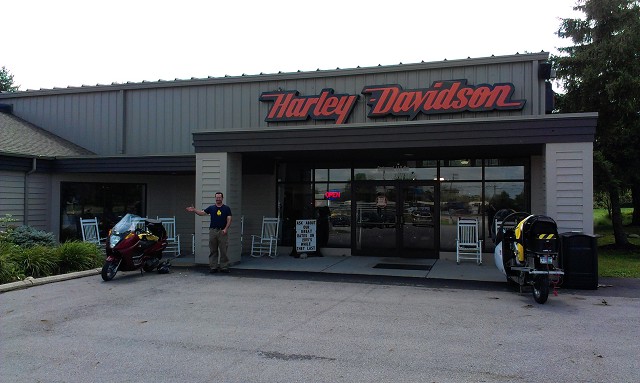 Ben explains that he was this close to making it to the turn around point. Burton Rosenburger was the electric chase vehicle and captured video at the event. Burton is adding a Vetter Streamliner body kit to a Race Version of a Zero S, unfortunately his bike was not ready for this event. 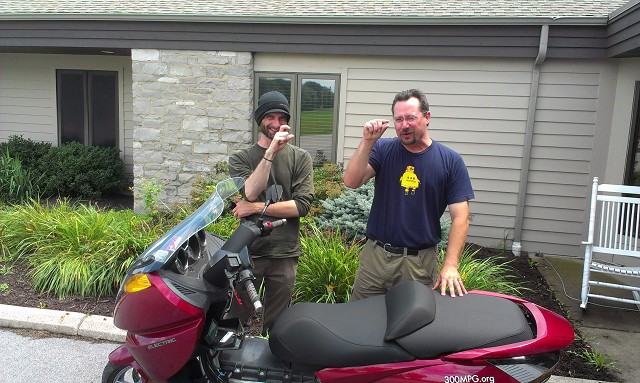 At this point, per the Cycle Analysts on the bikes, Kraig's bike had used 4141 Watt-Hours. Ben's bike had used 5379 Watt-hours. Ben recharged enough at the Harley Dealer to continue on to the museum, however his trailer ride back was just leaving the museum when he was ready to leave the dealership, so he ended up needing to be trailered from the Harley Davidson Dealership parking lot. Ben's Results were: Benjamin Nelson, Vectrix with Nissan Leaf Batteries 55.8 miles. 6,130 Watt-hours, 109.86 Watt-hrs/mile, $.0132 / mile + Vetter road tax. Account of the event by Ben Nelson, http://300mpg.org/2015/07/13/300mpg-orgs-electric-vectrix-wins-craig-vetter-fuel-economy-competition/ RICHARDS BIKE: Richard Goff was riding the same Zero DS as the previous two years. But, he was running an untested fairing. If the route and speeds were the same as previous years it was unknown if he could finish the route. If his homemade corroplast fairing was better than his Vetter fairing he could make it! Note: The nice Vetter fairing on Richards bike in 2014 was installed on the Students gasoline powered bike for this years ride. Richard was carrying two chargers and if he took advantage of charging stops along the way and had a full 1.5 hours of charging at the museum he felt he had a chance of making it with the main group. His contingency plan was to trailer the bike if it ran out of juice along the way, but he had done that the last two years and was determined that he did not want to do that a third year in a row. Richard rode with the electric riders until Ben's bike ran out of juice. He then continued on to the museum to meet the gasoline powered bikes and get his bike plugged in. The fossil fueled bikes left before he had gotten enough of a charge to return with them. By catching a two quick charges on the return trip, Richard completed his goal of not needing any trailering to complete the entire ride. 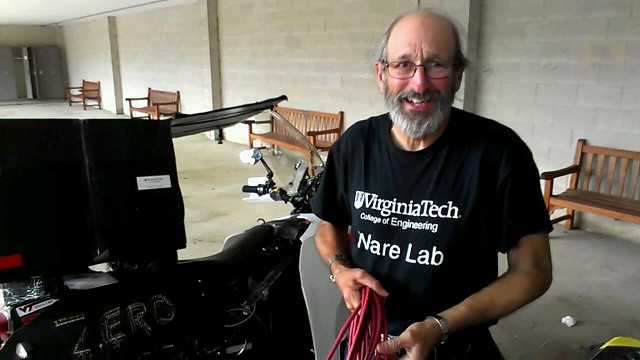 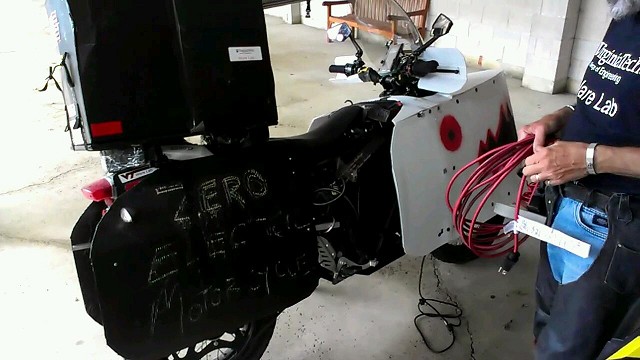 Richards results were: Richard Goff, 2013 Zero DS with Corroplast Streamlining 135.4 miles, 13.140 kilo-Watts from the wall, 97.05 watts-hr per mile, $0.0116 / mile + Vetter road tax. Ride there averaged 40-45mph, Ride back averaged 45-50mph. Richards performance history: 2013: 120 Wh/Mile (Vetter Speeds) 2014: 90 Wh/Mile (Vetter Speeds) 2015: 97 Wh/Mile (Electric Speeds) KRAIGS BIKE: Kraig Schultz was also sure he could not make the 75 mile trip at Vetter speeds with the group without stopping to charge up along the way. Kraig Schultz was running a pack made from Chevy Volt batteries (6.4 kW pack). 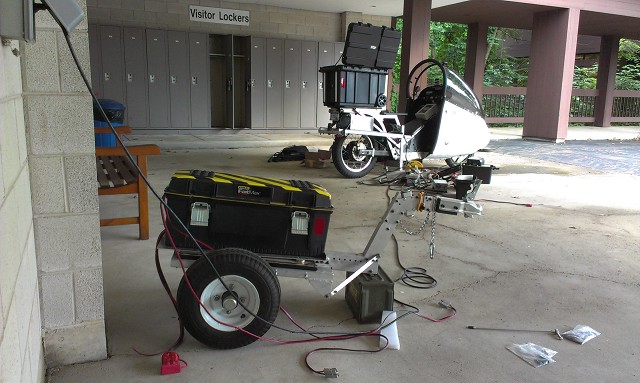 For the challenge ride, he put his trailer and camping gear in the Virginia Tech. chase vehicle to save some rolling resistance and was carrying 4 chargers and charging equipment in ammo boxes mounted on the bike. He planned to pick up his trailer and extra gear at the museum and continue his ride to Cincinnati. If he could find four separate 15 Amp 110VAC outlets he felt he could recharge his bike in 2 hours or less. Unfortunately, his chargers were not waterproof and had to be stowed in ammo boxes between charging sessions. To get all the charging equipment unpacked and stowed added at least 30 minutes to each charging session. At the end of the ride he fully recharged at the museum, but due to severe weather between Cincinnati and the museum, he called in his family for tailoring "home". 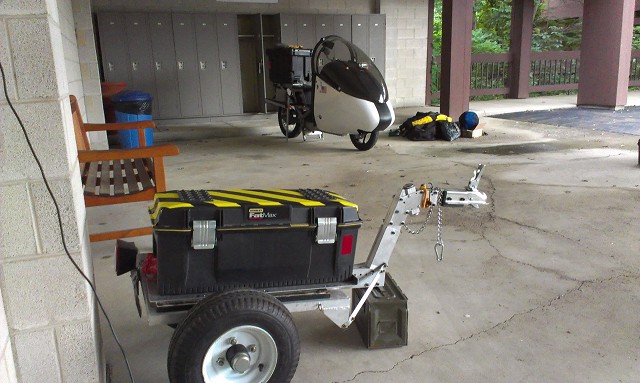 Kraig Results were: Kraig Schultz, Delta-11 Prototype with Chevy Volt Batteries 64.14 miles, 5.920 kilo-Watt-Hours from the wall to recharge, 92.3 Wh/Mile (from the wall), $.0111/Mile + Vetter road tax. RIDE OVERVIEW: Once we decided to take an alternate route from the fossil fuel bikes, the pressure was off. We had nothing to prove. We just wanted to be able to enjoy a safe ride and be able to compare the performance of the electric bikes to each other accurately. We stopped often to discuss how things were going. Were we riding too fast or too slowly? How were the batteries holding up? Were we going to make it there without having to stop to charge up? IMPACT OF RAIN: There was some light rain and wet roads for the first 45 miles. This is the first time Kraig had ridden in the rain in the 13,000 mile life of his bike and was surprised at how much more energy the bike was drawing than normal. It appeared to take 3,500 watts to ride 45mph in the rain vs. my the normal 3,000 watts at 45mph. That's a 16% difference. Burton said that Alan Smith had said rain typically cuts his fuel economy by 10%. Also, Kraig didn't know if maybe the extra ammo boxes or weight of batteries on the back of the bike were causing extra drag. We stopped one time to adjust the placement of the ammo boxes. Then, at the half way point we removed the rear ammo boxes and put them in Burtons car. But, at that point the rain stopped and the roads started getting dryer. In any case, with dry roads and no exterior ammo boxes, Kraig's bikes efficiency got better. Kraig thought that the slinging of the water off the wheels and the cooling effect of the water on the wheels created extra drag. Burton said Alan Smith thought it was aerodynamic drag of the water droplets on the exterior of the body. IMPACT OF SPEED: My bike is most efficient below 45mph so I wanted to ride at that speed or less. This was Ben's first long ride with his new battery pack and he did not know if he had enough battery capacity to ride 61 miles. As the ride progressed it became more evident that Ben's batteries might not make it, even at 40-45mph pace we were riding. The electric riders stopped often to talk about our fuel consumption (both Ben and Kraig had Cycle Analyst computers that allowed them to monitor energy consumption real-time). Ben indicated that he was running short on battery charge. With just under 10 miles to go, he decided he should charge to not damage his batteries by allowing them to over discharge. Once Ben was safely on charge at the Harley Davidson dealership, Kraig completed the ride to the Museum. It was Kraig's plan to continue on to Cincinnati where his family was to pick me up. But, there was only three outlets at the museum to charge and by the time his batteries were charged, severe weather was rolling in. Kraig called in for a trailer and with my batteries fully charged before leaving the museum, trailered my bike, for the stormy ride "home". VIDEO FOOTAGE: Ben was wearing a helmet cam from Edwin EOC films. Burton Rosenberger drove a chase car behind the group collecting more video footage. FUTURE ROUTE POTENTIAL: At the 30 mile mark we found a charging paradise: The Centerburg Community Memorial Park has four covered pavilions with picnic tables, all wired with 120VAC outlets around the perimeter. There are toilets and twelve, RV 50 Outlets on the parking lot. It would make a perfect rest stop with charging and possibly lunch during a ride. This is picture taken at Centerburg Community Memorial Park  We each struggled with the challenges we faced trying to get charged during this ride. The biggest lesson of this ride was that we had hardship because we didn't know where the good charging would be. As it turned out, the ideal recharge point was the Centerburg Community Park (it was at the half-way point between the hotel and the museum). WHO WON? It seems like it was a tie between Richard and Kraig. The data we have shows that Kraig had a lower $/mile, but Kraig only rode halfway and Richard rode both ways AND at higher speeds on the return trip. But, on the way there, we rode in rain that was causing much greater energy consumption. Kraig says that Richard "won". Richard says the Kraig "won". No one really cares, we had a great time and want to do it again next year! Riders meeting at mid-way point (AMA Museum). 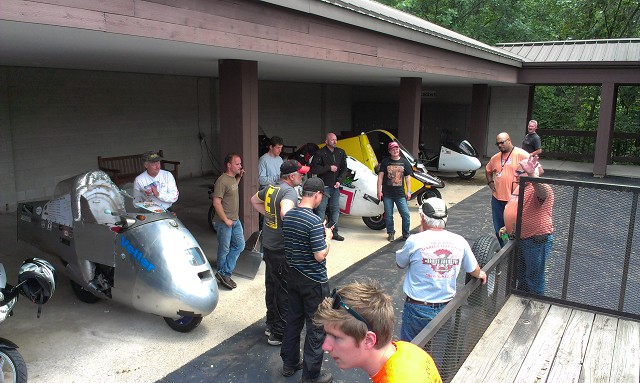 Riders leaving mid-way point (AMA Museum). Ironically, lined up in their pole positions in respective order for winning the event (Alan Smith, Vic Valdes, Scott Endler). 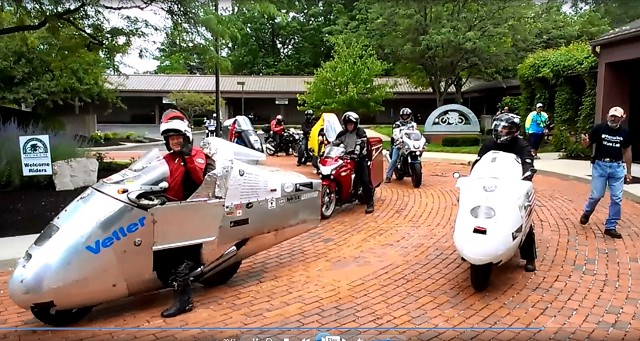 Fossil Fueled Results source www.CraigVetter.com, Note: $.12/kWh was used for Electric cost calculations, NOT $.07/Mile listed on the following picture. Also, none of the electric riders actually paid anything for electricity to recharge their bikes and since we don't pay road taxes either. 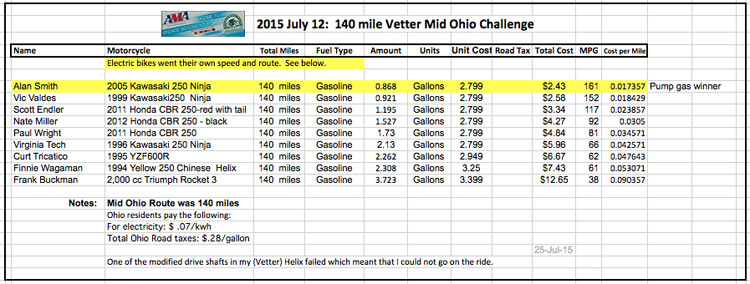 SCHULTZ ENGINEERING CHALLENGE HISTORY: 2011: Electric Riders ride 38 miles with the Fossil fueled bikes and then recharge and return to the starting point (riding 76 miles total). Delta-11 got estimated 95 Wh/mile, $.011/Mile. Ride was with Vetter group out to 38 miles at 55 mph and returned to Mid-Ohio at 40mph. http://www.schultzengineering.us/delta-11-3.htm 2012: Did "Future of Electric Motorcycles" talk http://deltabike.us/future.pdf Delta-11 rained out of event. Bike not waterproof and so could not ride. Did Saturday Evening ride to dinner with electrics and Alan and Vic and Noah at 55mph target speed, 28.1 miles, average speed 39.7, 2.93kW = 104.3 Wh/Mile from the wall. http://www.deltabike.us/120720.htm 2013: Due to work schedule, Delta-11 could not ride in Challenge. On Saturday evening reviewed 2 position seating with Craig Vetter, Alan S. and Vic V. in parking lot. On Sunday morning did ride with Alan Smith, Vic V., and Richard Goff. 34.9 Miles, 45.3 mph average speed, 70.5 mph max speed, 88.5 Wh/mile. http://www.schultzengineering.us/delta-11-9.htm 2014: Did not attend mid-Ohio event due to work schedule http://www.deltabike.us/events.htm 2015: Did "State of Electric Motorcycle Talk" http://www.schultzengineering.us/state-2015.pdf Alan, Vic and Craig V. test ride the Delta-11 prototype. First that anyone other than Kraig has ridden the proto-type. After four years of trying, the Delta-11 prototype finally completed one leg of a Vetter Challenge! This year several changes were made to ensure the Delta-11 bike was waterproof and that it carried enough battery capacity to at least complete one leg of the Challenge. Rode in rain 50 miles, target speed 43mph. 64.14 miles, average speed 35.0, 92.3 Wh/Mile from the wall, $.0111/mile + road tax. PROJECT CLOSURE: From Kraig Schultz's Delta-11 Logbook: "7/12/2015: Closure of D-11 Project. Today, I sat on a park bench at the AMA museum and chatted with Craig Vetter (with his dog Riley resting between us) about the meaning of life. He (Craig) then rode the Delta-11 prototype and I am at peace with the project. I've accomplished what needed to be done and I am freed to move on to the next era of my life; Sustainable, energy production and use." Picture Source, www.CraigVetter.com 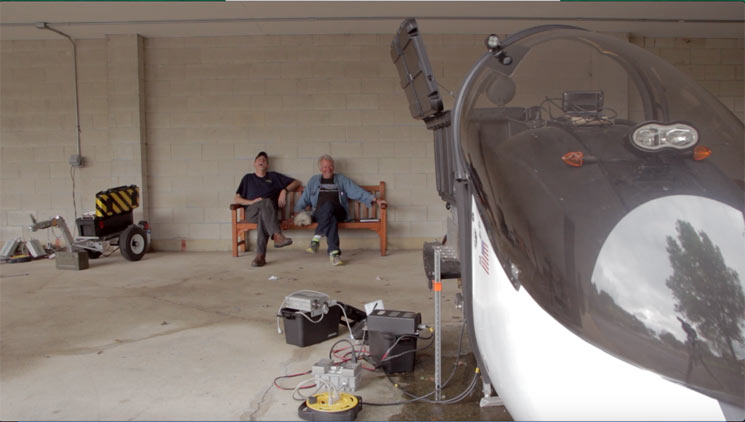 Here's a picture I took of Craig Vetter sitting in front of his original streamliner from the 1980's while he told me the story about how it started out the "only proper color for a streamliner (silver)" and got painted blue after being broken in two in a crash. 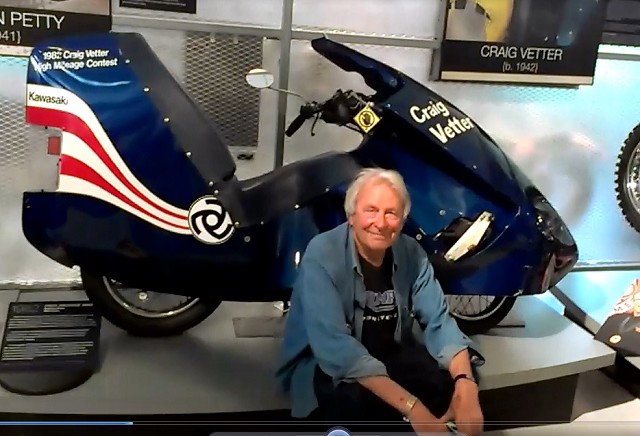 |
|
(Next Page) |
|
Inventing a better tomorrow today... Copyright 2015, Schultz Engineering, LLC, written by Kraig Schultz |